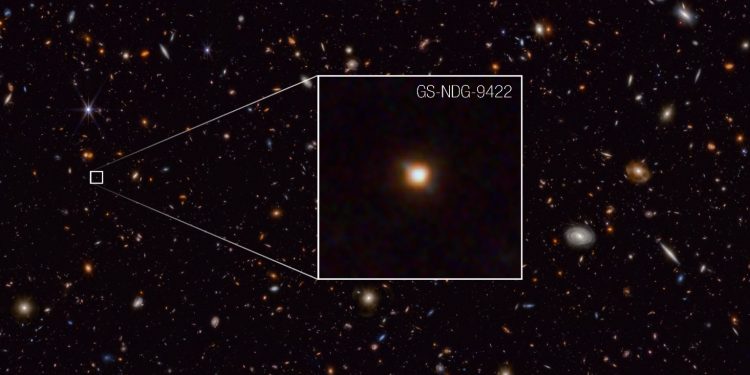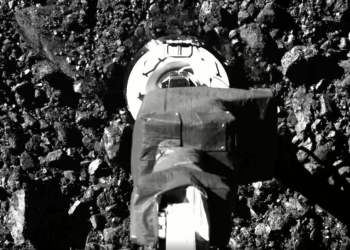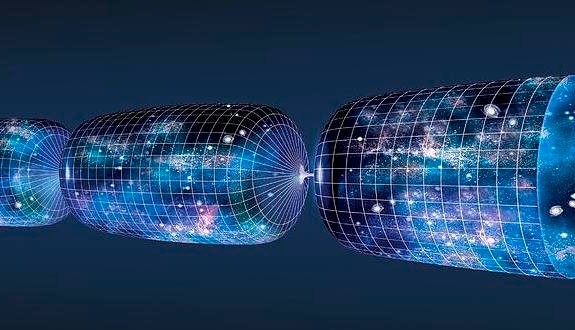Astronomers have made a groundbreaking discovery in the early universe—an unusual galaxy that may hold the key to understanding how the cosmos unfolded after the Big Bang. This enigmatic galaxy, named GS-NDG-9422, was detected roughly a billion years after the Big Bang, and its defining feature is an odd, never-before-seen light pattern where its gas outshines its stars. According to researchers, this phenomenon could represent a critical stage in the evolution of galaxies, bridging the gap between the universe’s earliest stars and the fully formed galaxies we are familiar with today.
The James Webb Space Telescope (JWST) made this extraordinary observation. The telescope’s ability to peer deep into the universe’s history allowed scientists to capture this unprecedented glimpse into the distant past. GS-NDG-9422’s unique light signature immediately caught the attention of researchers, as it revealed characteristics unlike anything previously observed in galactic evolution.
Lead researcher Dr. Alex Cameron from the University of Oxford remarked, “The galaxy’s spectrum immediately struck me as bizarre. This is exactly the type of surprising discovery that the Webb telescope was built for—new phenomena in the early universe that shed light on how everything began.”
Theoretical Insights into Extreme Stars and Gas Clouds
To further investigate, Dr. Cameron teamed up with theorist Dr. Harley Katz from the University of Chicago and Oxford. Together, they ran simulations and analyzed the data, concluding that the gas in this galaxy is being heated by stars so massive and hot that it outshines the stars themselves. These stars appear far more extreme than what we encounter in the local universe, with temperatures soaring past 140,000 degrees Fahrenheit (80,000 degrees Celsius)—almost double the heat of typical stars today.
Katz explained, “These stars must be vastly hotter and more massive, which aligns with the early universe’s distinct environment. The extreme conditions at that time led to the formation of stars unlike those we see in the present-day cosmos.”
The discovery of GS-NDG-9422 might serve as a crucial puzzle piece in the study of galactic formation. Researchers suggest that this galaxy is currently experiencing a short-lived yet intense period of star formation within dense gas clouds, producing an unusual number of massive stars. This phase, characterized by nebular gas shining more brightly than the stars, closely matches theoretical predictions about the universe’s first stars—classified as Population III stars.
However, there’s a twist. Despite its strange star activity, GS-NDG-9422 doesn’t appear to host Population III stars. The chemical complexity observed in its data suggests that the galaxy has already evolved beyond this phase, but its stars are still unique enough to offer valuable insights into the transition from primordial stars to more familiar galaxies.
Unanswered Questions and Future Research
At present, GS-NDG-9422 is one of the few known galaxies exhibiting this extreme behavior. This leaves astronomers with a host of intriguing questions: Are there more galaxies like this in the early universe? How common were these conditions? What further clues can they offer about even earlier cosmic history?
Cameron, Katz, and their colleagues are already hard at work identifying more galaxies to add to this unique category, hoping to answer these questions and gain a better understanding of the universe’s infancy.
“The ability to study this period, which was previously beyond our reach, is truly thrilling,” said Cameron. “This is just the beginning of a new era of cosmic discovery.”
The discovery of GS-NDG-9422 by the JWST has opened a new window into the universe’s earliest days, revealing a galaxy where gas outshines stars in a way never seen before. As researchers continue to analyze this and other galaxies from the early universe, these findings promise to deepen our understanding of how the cosmos developed after the Big Bang, bringing us one step closer to uncovering the secrets of our cosmic origins.











